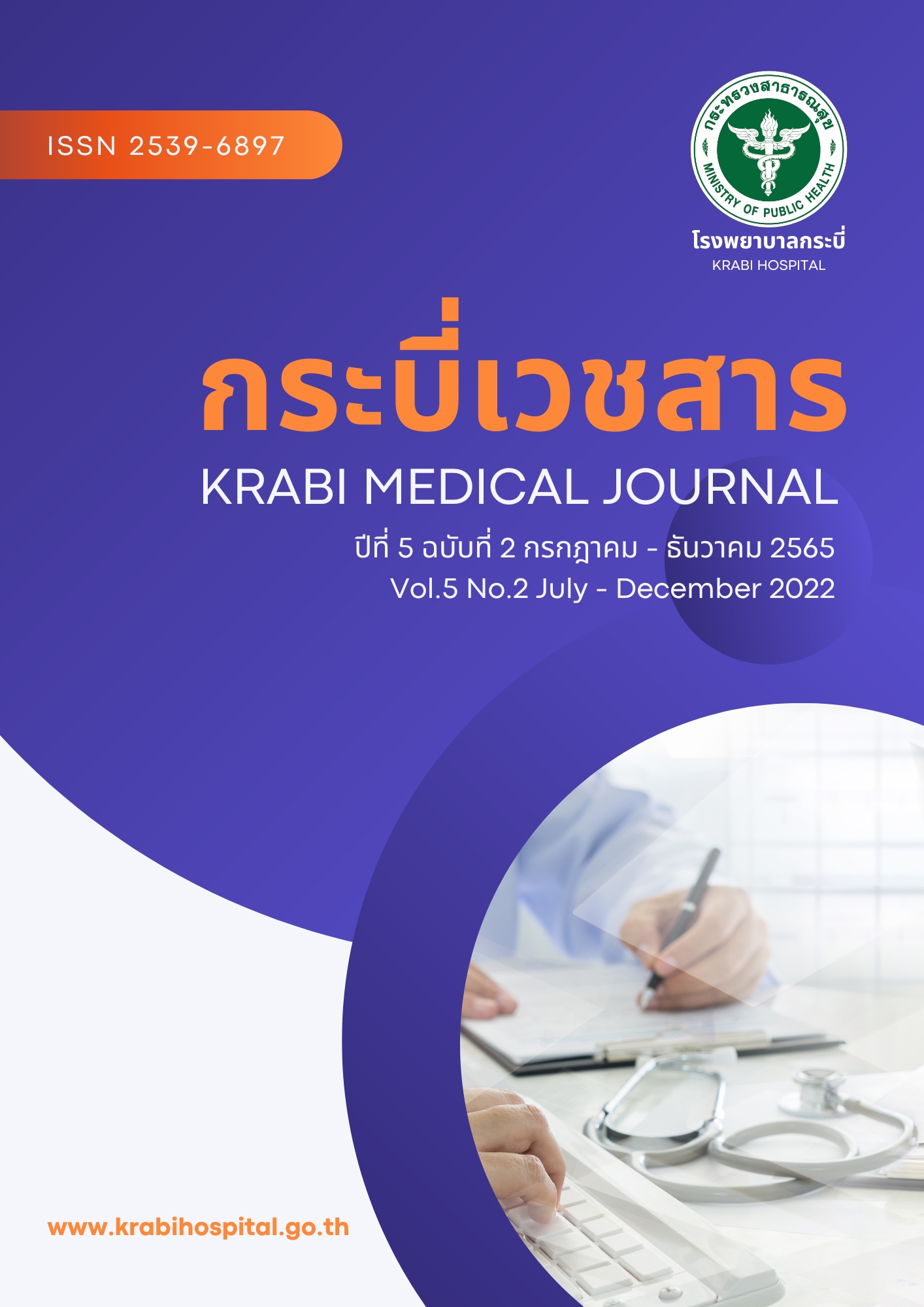The relationship between abdominal circumference and intravenous ephedrine dose during elective cesarean section under spinal anesthesia
Main Article Content
Abstract
Background: Gravid uterus caused increased abdominal pressure and greater engorgement of the epidural venous resulted in a smaller CSF volume and greater cephalad spread of sensory blockade. We hypothesized that abdominal circumference could reflect the effect of gravid uterus and incidence of hypotension after spinal anesthesia.
Objective: The aim of this study was to evaluate the relationship between abdominal circumference and the amount of intravenous ephedrine dose to treat hypotension during elective cesarean section under spinal anesthesia.
Method: A prospective observational study was conducted in fifty parturients scheduled for elective cesarean section. Abdominal circumference was measured before spinal anesthesia. The blood pressure were obtained at 1st, 2nd, 3rd, 4th, 5th, 7th, 10th, 15th and 20th minutes after spinal injection. The amount of ephedrine to treat hypotension and the maximum level of sensory blockade at the 15th were recorded.
Results: The mean abdominal circumference was 101.10 ± 10.20 cm. There were 27 (54%) patients who had decreased blood pressure and received intravenous ephedrine. There was no significant correlation between abdominal circumference and intravenous ephedrine dose (p-value=0.422), and there was no significant correlation between abdominal circumference and the level of maximum sensory blockade (p-value = 0.945)
Conclusion: Abdominal circumference was not correlated with the amount of intravenous ephedrine dose during elective cesarean section under spinal anesthesia.
Article Details

This work is licensed under a Creative Commons Attribution-NonCommercial-NoDerivatives 4.0 International License.
บทความนิพนธ์ต้นฉบับจะต้องผ่านการพิจารณาโดยผู้ทรงคุณวุฒิที่เชี่ยวชาญอย่างน้อย 2 ท่าน แบบผู้ทรงคุณวุฒิ และผู้แต่งไม่ทราบชื่อกันและกัน (double-blind review) และการตีพิมพ์บทความซ้ำต้องได้รับการอนุญาตจากกองบรรณาธิการเป็นลายลักษณ์อักษร
ลิขสิทธิ์
ห้ามนำข้อความทั้งหมดหรือบางส่วนไปพิมพ์ เว้นว่าได้รับอนุญาตจากโรงพยาบาลเป็นลายลักษณ์อักษร
ความรับผิดชอบ
เนื้อหาต้นฉบับที่ปรากฏในวารสารเป็นความรับผิดชอบของผู้เขียน ทั้งนี้ไม่รวมความผิดพลาดอันเกิดจากเทคนิคการพิมพ์
References
Tsen LC. Anesthesia for cesarean delivery. In: Chestnut DH, Wong CA, Tsen LC, Ngan KEE WD, Beilin Y, Mhyre JM. Chestnut’s Obstetric Anesthesia. 5thed. Philadelphia: Mosby Elsevier; 2014. p545-603.
Ronenson AM, Sitkin SI. Effect of intra-abdominal pressure in pregnant women on level of spina block and frequency of hypotension during cesarean section. Anesteziologiya I Reanimatologiya. 2014;59:26–29.
Birnbach DJ, Brown IM. Anesthesia for obstetrics. In: Miller RD, Eriksson L, Fleisher L, Wiener-Kronish JP, Young WL. Miller’s Anesthesia.8thed. Philadelphia: Churchill Livingstone. 2015. p 2328-47.
Somboonviboon W, Kyokong O, Charuluxananan S, Narasethakamol A. Incidence and risk factors of hypotension and bradycardia after spinal anesthesia for cesarean section. J Med Assoc Thai. 2008;91(2):181-7.
Chumpathong S, Chinachoti T, Visalyaputra S, Himmungan T. Incidence and risk factors of hypotension during spinal anesthesia for cesarean section at Siriraj Hospital. J Med Assoc Thai. 2006;89(8):1127-32.
Norris MC. Height, Weight and the spread of subarachnoid hyperbaric bupivacaine in the term parturient. Anesth Analg 1988;67:555-8.
Chung SH, Yang HJ, Lee JY, Chung K, Chun D, Kim B. The relationship between symphysis-fundal height and intravenous ephedrine dose in spinal anesthesia for elective cesarian section. Korean J Anesthesiol 2010;59(3):173-8
วิชญา ศุภโอภาสพันธุ์, ลิษา สังข์คุ้ม, ศรัญยา ภูวนวิโรจน์. ความสัมพันธ์ระหว่างความสูงของยอดมดลูกและระดับการชาสูงสุดในการระงับความรู้สึกทางช่องไขสันหลังในการผ่าตัดคลอด. วิสัญญีสาร 2562;45(4):146-50.
Ozkan ST, Orhan SM, Basaran B, et al. The effect of intra-abdominal pressure on sensory block level of single-shot spinal anesthesia for cesarean section: an observational study. International Journal of Obstetric Anesthesia. 2015;24(1):35–40.
Kuok C, Huang C, Tsai P, et al. Preoperative measurement of maternal abdominal circumference relates the initial sensory block level of spinal anesthesia for cesarean section: an observational study. Taiwanese Journal of Obstetrics and Gynecology. 2016;55(6):810–814.
Zhou Q, Xiao W, Shen Y. Abdominal girth, vertebral column length, and spread of spinal anesthesia in 30 minutes after plain bupivacaine 5 mg/mL. Anesthesia & Analgesia. 2014;119(1):203–206.
Sugerman H, Windsor A, Bessos M, Wolfe L. Intra-abdominal pressure, sagittal abdominal diameter and obesity comorbidity. Journal of Internal Medicine. 1997;241(1):71-9.
Zhang N, He L, Ni JX. Level of sensory block after spinal anesthesia as a predictor of hypotension in parturient. Medicine (Baltimore). 2017;96.


